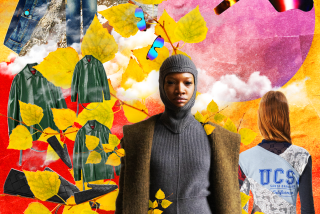Designers Play It Safe, Stick to Recycling Bin
MILAN--Poor Giorgio Armani.
He is one of the most successful fashion designers of all time. He taught women how to dress in menswear and men how to dress up. But after 27 years in business, the designer is starting to feel like a prisoner of supple suiting.
And so, earlier this week, for his fall collection, the designer showed something different: Among his clothes, inspired by the first female aviators, were (gasp) harem stirrup pants.
The distaste in the Armani Teatro was palpable. One editor giggled to a pal across the runway, another rolled her eyes. Reviews the next morning in the Italian and international press were horrific. Sitting in his minimalist chic office in the city center, his portrait hanging on the wall near his desk, Armani was furious.
“Every time I do something that’s slightly more provocative, rather than what I’m expected to do, they focus on that. They didn’t see any of the jackets, the knitwear, the accessories. It’s something I can’t easily accept,” he said, tan fist pounding the blond wood of his desk. “When Chanel puts a funny hat on the runway, nobody says anything, but it’s not expected of me. I think I have the same right. I want the Armani style to be alive.”
He showed an exhaustive collection Monday of more than 100 looks worn by models in leather helmets and goggles. There were some of his classic softly tailored “greige” jackets women the world over will continue to buy.
With the luxury market already sagging before Sept. 11, nobody else was much in the mood to take risks during the fall collections this week. Mostly, designers seemed eager to get back to the business of selling clothes, as swiftly and surely as possible.
Today’s fashion designers are in quite a pickle. To get noticed, they have to create something new. But to stay noticed, they have to create a bankable image, which often means sticking to what critics and customers expect.
When rock stars want guaranteed cash, they put out greatest hits albums, and that’s what many designers seemed to be doing. Rather than charting new territory, they chose to play it safe, revisiting old themes or recycling classics.
There weren’t many new trends: High boots were big, again, as well as chunky wool scarves and sweaters in winter white. Fur or shearling vests are still on the radar, along with belts, from the wide croc variety to the obi.
Some designers did dabble in alternative pant shapes--black drainpipe trousers that bunch at the ankle at Gucci, leggings tucked into high boots at Max Mara, khakis with contrast color cuffs at Miu Miu and satin-trimmed velvet bloomers at Emporio Armani.
Burberry’s Chris Bailey made a case for culottes, the divided skirts first worn by women in the 1900s for cycling, then revived and renamed gauchos in the 1960s and 1970s.
Instead of the ubiquitous plaid, Bailey based his collection on the trench coats that made the company famous, playfully attaching epaulets and buttoned flaps to wool culottes, trousers and box-pleat skirts. On top, he stayed loyal to Brit classics, including paisley corduroy blazers and nubby wool sweaters.
For Miu Miu, designer Miuccia Prada was also stuck on the iconic trench, which she made into a cropped jacket, a coat dress, a halter top and a tote. She offered patent leather boots, shown in black, green, yellow and red, and rain hats that would make Paddington Bear proud.
Prada made her name in quilted nylon, and she used the sturdy fabric to fashion coats, zip-up jackets and pants with elastic at the ankles in classic navy blue. She also trotted out wool short shorts (fantasy items for sure) paired with polo shirts or anoraks and delicious Betty Grable-esque sequined pumps with ankle straps.
“I like the idea of hiking in high heels,” the designer said of the shoes after the show. “It’s OK because the woman for fall is strong.”
Most designers anticipated that women would want to look self-assured in these uncertain times and that they aren’t about to open their wallets for just anything.
Tom Ford brought back the tough-talking Gucci woman of the 1990s, when he and the house were in their heyday. And Prada’s pricey signature line took a sexier spin through the familiar territory of lingerie looks, sheer blouses and pretty evening skirts--all bestsellers for her in the past.
Roberto Cavalli didn’t do much to deviate from his foxy lady luxe formula. A body-hugging silk panther print halter gown and a pink, bugle-bead dress that was one part flapper, one part Radio City Rockette, are just two of many evening looks that seem destined for the red carpet.
And then there is Cavalli’s painted denim, this season treated in metallic animal prints, which always seems to land on lots of L.A. lovelies. In the points between formal and everyday, however, Cavalli was less consistent. Silk shirts and anorak jackets in trompe l’oeil jewel prints looked trashy, as did mohair sweater dresses and bum-hugging, colored fur suits. Too many reruns of “Dynasty” and “Falcon Crest,” perhaps?
Donatella Versace, on the other hand, rolled out a collection with a 1960s psychedelic bent that rocked from start to finish. She breathed new life into her trademark coats, offering them in a kaleidoscope of colored leather and adding embroidered silk trim to the cuffs and hems. Flirty, fitted bodice dresses dazzled in electrifying acid-house prints, while featherweight chiffon gowns in body-baring silhouettes were tie-dyed in shades of turquoise, pink and orange.
After the show, actress Molly Shannon said it best: “It’s a woman’s dream.”
And if that doesn’t fatten designers’ coffers, nothing will.







